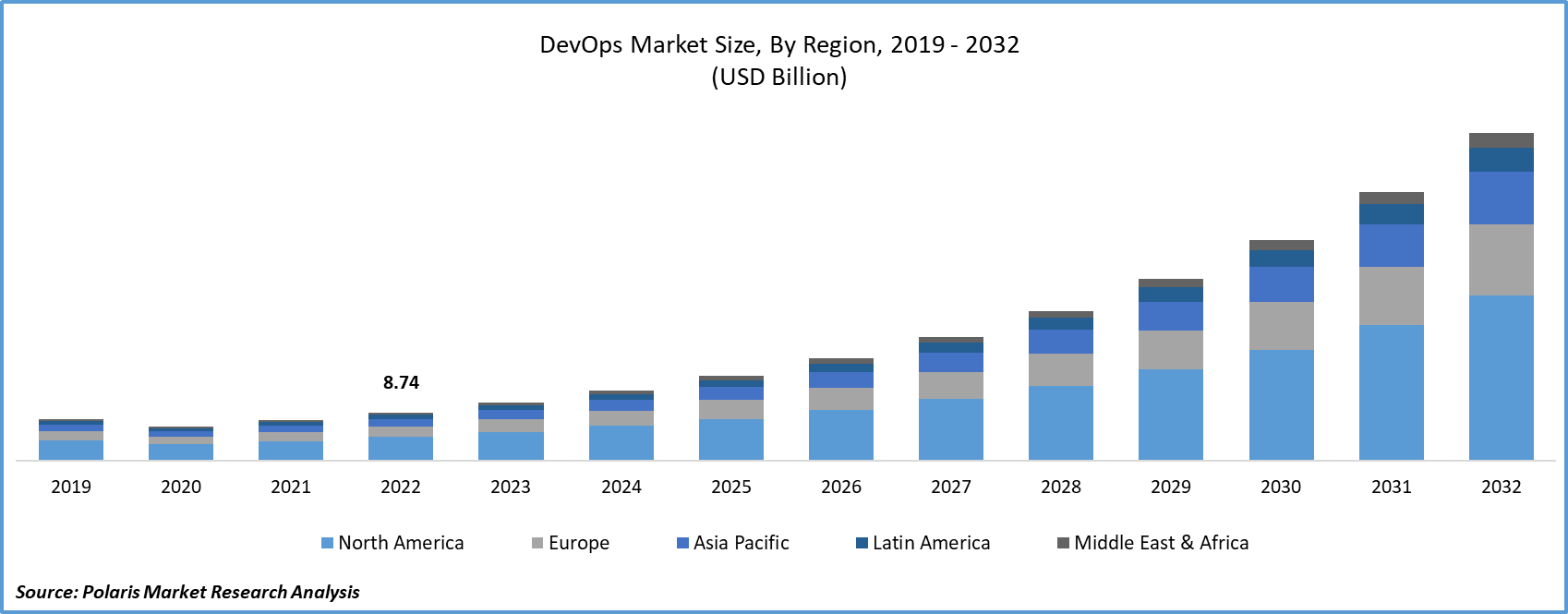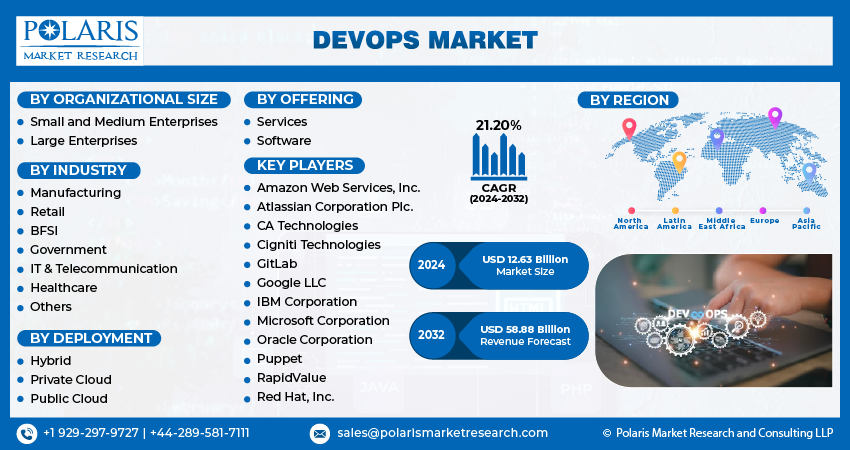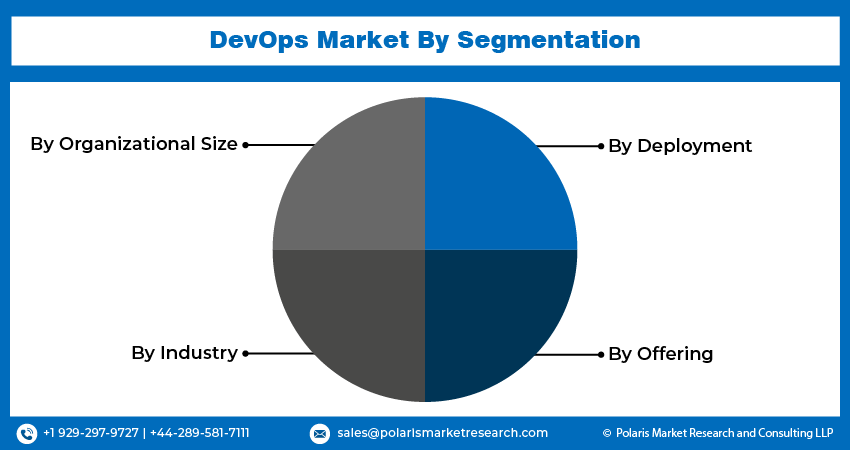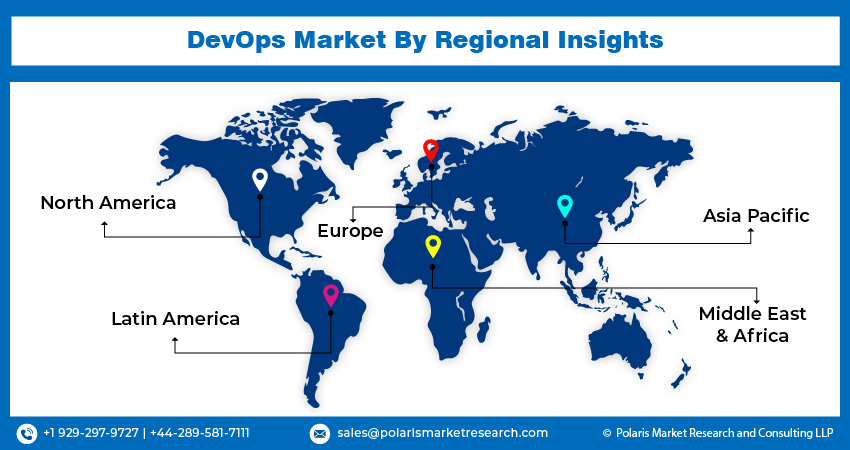
DevOps Market Share, Size, Trends, Industry Analysis Report, By Organizational Size (Small and Medium Enterprises, Large Enterprises); By Industry; By Deployment; By Offering; By Region; Segment Forecast, 2024 - 2032
- Published Date:Jan-2024
- Pages: 119
- Format: PDF
- Report ID: PM3958
- Base Year: 2023
- Historical Data: 2019-2022
Report Outlook
The global devops market was valued at USD 10.5 billion in 2023 and is expected to grow at a CAGR of 21.20% during the forecast period.
The DevOps market report details key market dynamics to help industry players align their business strategies with current and future trends. It examines technological advances and breakthroughs in the industry and their impact on the market presence. Furthermore, a detailed regional analysis of the industry at the local, national, and global levels has been provided
An increasingly intricate IT infrastructure, combining physical, virtual, and cloud environments, has heightened the complexity of IT processes. In response, DevOps steps in, relieving humans of substantial management tasks through automation. This is one of the reasons why organizations are striving for extensive DevOps automation and advanced container orchestration while selecting cloud hosting for their workloads. The collaboration between development and operations accelerates an organization's ability to deliver applications and enhance customer services. Software Deployment Operations (SDO) performance plays a pivotal role, setting teams and organizations apart in various industries, as it enables the optimization of software applications for superior outcomes. Integrating DevOps practices and capabilities during technological transformation yields dividends in terms of organizational performance and the quality of results.
DevOps is a combination of the terms development and operations that’s meant to unite people, processes, and technology. It aims at improving the speed, security and efficiency of software development and delivery as compared to traditional processes. Coming from an agile approach to software development, DevOps expands on the cross-functional approach of deploying applications in a fast and iterative way. It aims at shortening the system development lifecycle and offering continuous delivery with top-notch software quality.
The core DevOps principles take the form of the automation of the software development lifecycle, and collaboration and communication. Also, it places a major emphasis on continuous improvement and minimization of water and hyperfocus on user requirements with short feedback loops. DevOps finds applications across several sectors, including manufacturing, retail, BFSI, government, IT & communication, and healthcare. The ability of DevOps tools to streamline development within collaborative environments has increased their popularity, thereby driving the DevOps market growth.

To Understand More About this Research: Request a Free Sample Report
DevOps tools offer a multitude of advantages, including enhancing agility, fostering quality innovation, and minimizing production disruptions. Some key categories of DevOps tools encompass configuration management tools, API tools, application and infrastructure monitoring tools, collaboration and organizational tools, and build automation tools. DevOps is envisioned as the future of automating the application lifecycle. Automating repetitive tasks accelerates and streamlines operations, allowing teams and organizations to enhance work quality, iteration speed, and consistency. Moreover, it frees up time otherwise spent on low-value tasks. With escalating levels of automation, industry leaders provide technical teams with the freedom to focus on innovative initiatives that deliver added value to organizations.
At the outset of the DevOps journey, core elements such as deployment automation, continuous integration, version control, and infrastructure automation are typically acknowledged. As development and operations teams develop a stronger appreciation for the benefits of cooperation and knowledge sharing, they rapidly embrace various technologies and processes. This accelerates the exchange of insights, ideas, metrics, methodologies, and enabling tools. Nonetheless, the implementation of DevOps encounters particular challenges, including the absence of a universally agreed-upon definition, a lack of standardization in the approach to the adoption of development and operations practices, and the necessity for tailoring each implementation to its unique context.

Industry Dynamics
Growth Drivers
- Increasing Adoption of DevOps Tools to Boost Market Demand
The surging popularity of DevOps tools stems from their ability to streamline development within collaborative teams while minimizing errors. These tools play a crucial role in enhancing the security and stability of the software deployment process. Key trends in the development and operations software market include the prominence of Platform-as-a-Service and containerization. The virtualization of these services is emerging as a significant trend, simplifying the implementation of DevOps.
The market is also experiencing growing demand for heightened operational flexibility, enhanced client satisfaction, and the integration of the Internet of Things (IoT). DevOps serves as a distinct approach to enterprise software development, emphasizing the necessity of cooperation, automation, and communication between software developers and IT operations teams. It is an amalgamation of two well-established methods: Agile Development and Agile System Administration. DevOps tools significantly facilitate the development process, elevating its quality, reducing errors, and enhancing security and operational procedure maintenance.
Report Segmentation
The market is primarily segmented based on organizational size, industry, deployment, offering, and region.
|
By Organizational Size |
By Industry |
By Deployment |
By Offering |
By Region |
|
|
|
|
|
To Understand the Scope of this Report: Speak to Analyst
By Deployment Analysis
- The Public Cloud segment held the largest revenue share in 2022
The segment is driven by the increasing adoption of cloud technologies and frameworks, alongside the digital transformation of enterprises aimed at automating business processes and unlocking significant operational potential. Emerging tech trends like artificial intelligence (AI) and machine learning (ML) are providing a significant boost to the market. AI and ML algorithms excel in processing vast datasets, handling routine tasks, allowing professionals to focus on targeted work, discern patterns, identify issues, and propose solutions.
The dominance of the public cloud segment, is attributed to the surging demand for cloud-based solutions in system architectures and web servers across various industries. Public cloud offerings include accessibility, remote access, rapid deployment, and a range of enterprise advantages such as scalability and flexibility, all contributing to its widespread adoption.
By Industrial Analysis
- The IT & Telecommunication segment accounted for the highest market share during the forecast period
Industries spanning healthcare, manufacturing, banking, insurance, and finance are transitioning towards automated software deployment to achieve greater precision, efficiency, and reduced maintenance expenses. The IT & telecommunication sector has claimed the lion's share of the market in recent years. It is projected to maintain its leading position over the next five years, driven by the escalating demand for swift delivery services. Currently, industries like IT & telecom, BFSI, and retail stand as the foremost end-users of DevOps tools. The market is poised for growth in these segments, fueled by the uptick in online and mobile transactions and the increasing need for an enhanced customer experience.
By Organizational Size Analysis
- The Large Enterprises segment accounted for the highest market share during the forecast period
Historically, the primary adopters of DevOps have been large enterprises, which have shown a greater propensity for deploying DevOps solutions to manage their critical business operations. Large enterprises have been at the forefront of embracing DevOps to elevate quality and efficiency, streamline processes, expedite time-to-market, and trim down costs associated with IT operations, including software development, delivery, and maintenance. However, in the case of small and medium-sized enterprises (SMEs), several challenges, such as a shortage of skilled workforce, a preference for traditional methods, and the requirement for standardized DevOps tools, have impeded the widespread adoption of DevOps practices.

Regional Insights
- North America dominated the largest market in 2022
In 2022, North America led the DevOps market in terms of revenue, primarily due to its widespread adoption in various industries, including IT & telecommunication, retail, and BFSI.
In Europe, numerous banks have incorporated DevOps into their software processes, resulting in a 25% improvement in the efficiency of updating applications like internet banking. This shift has lightened the workload for IT operations teams, enabling them to concentrate on delivering added value to the company's business operations. Projections indicate that the Latin America (LATAM) and Middle East & Africa (MEA) markets are poised for substantial growth.
The Asia-Pacific DevOps market is anticipated to experience the most substantial Compound Annual Growth Rate (CAGR) in the forecast period, driven by the increasing need for automated software solutions in Small and Medium Enterprises (SMEs) across countries like Singapore, Japan, and China. This region has witnessed a notable increase in the number of SMEs necessitating the adoption of DevOps tools to enhance the agility and efficiency of their business operations. Additionally, the ongoing development of advanced infrastructure and the growing prevalence of smart devices, smartphones, and digital services in emerging APAC nations are expected to propel market expansion.

Key Market Players & Competitive Insights
The market is characterized by intense competition, with established players relying on advanced technology, high-quality products, and a strong brand image to drive revenue growth. These companies employ various strategies such as research and development, mergers and acquisitions, and technological innovations to expand their product portfolios and maintain a competitive edge in the market.
Some of the major players operating in the global market include:
- Amazon Web Services, Inc.
- Atlassian Corporation Plc.
- CA Technologies
- Cigniti Technologies
- GitLab
- Google LLC
- IBM Corporation
- Microsoft Corporation
- Oracle Corporation
- Puppet
- RapidValue
- Red Hat, Inc.
Recent Developments
- In December 2022, Copado, a provider of Continuous Delivery (CD) and Continuous Integration (CI) services, has introduced the DevOps Exchange tailored for enterprise Software as a Service (SaaS) solutions. This Exchange showcases pre-built solutions contributed by the Copado community, augmenting the features and functionalities of Copado's DevOps platform for Salesforce.
- In May 2022, IT service management firm Claranet has successfully acquired Geko Cloud in Spain, bolstering its cloud and DevOps offerings within the region. This acquisition enables Claranet to provide advanced cloud consulting services, container as a service, digital modernization, cloud infrastructure management, and microservices to its clientele.
DevOps Market Report Scope
|
Report Attributes |
Details |
|
Market size value in 2024 |
USD 12.63 billion |
|
Revenue forecast in 2032 |
USD 58.88 billion |
|
CAGR |
21.20% from 2024 – 2032 |
|
Base year |
2023 |
|
Historical data |
2019 – 2022 |
|
Forecast period |
2024 – 2032 |
|
Quantitative units |
Revenue in USD billion and CAGR from 2024 to 2032 |
|
Segments Covered |
By Organizational size, By Industry, By Deployment, By Offering, By Region |
|
Regional scope |
North America, Europe, Asia Pacific, Latin America; Middle East & Africa |
|
Customization |
Report customization as per your requirements with respect to countries, region and segmentation. |
Gain profound insights into the 2024 DevOps market with meticulously compiled statistics on market share, size, and revenue growth rate by Polaris Market Research Industry Reports. This thorough analysis not only provides a glimpse into historical trends but also unfolds a roadmap with a market forecast extending to 2032. Immerse yourself in the comprehensive nature of this industry analysis through a complimentary PDF download of the sample report.
Browse Our Top Selling Reports
Legal Services Market Size, Share 2024 Research Report
Paper Straw Market Size, Share 2024 Research Report
SMS Firewall Market Size, Share 2024 Research Report
Virtual Sports Market Size, Share 2024 Research Report
Consumer Genomics Market Size, Share 2024 Research Report
